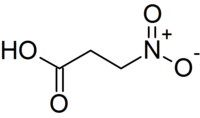β-硝基丙酸
| Β-硝基丙酸 | |
|---|---|

| |
| 识别 | |
| CAS号 | 504-88-1 |
| PubChem | 1678 |
| ChemSpider | 1615 |
| SMILES |
|
| InChI |
|
| InChIKey | WBLZUCOIBUDNBV-UHFFFAOYAZ |
| 性质 | |
| 化学式 | C3H5NO4 |
| 摩尔质量 | 119.08 g·mol−1 |
| 熔点 | 65-67 °C |
| 若非注明,所有数据均出自标准状态(25 ℃,100 kPa)下。 | |
β-硝基丙酸(3-硝基丙酸,BPA,3-NPA,C3H5NO4)是一种真菌毒素,其对线粒体有抑制作用对人体有毒[1]。许多真菌产生这种毒素,因此广泛存在于食品如甘蔗,以及通过真菌发酵的日本主食味噌、酱油、鲣鱼干[2]和一些中药中[3]。
研究发现β-硝基丙酸是一种线粒体毒素并且在大鼠模型中产生类似于在亨廷顿氏病患者的脑中观察到的纹状体改变,并且在大鼠注射3-NPA之前连续六天施用大麻素受体激动剂WIN55212-2,通过激活CB1受体,对毒素引起如线粒体功能障碍和脂质过氧化,发挥预防作用[4]。
参考文献[编辑]
- ^ Roberts, Toby John. 3-Nitropropionic Acid Model of Metabolic Stress: Assessment by Magnetic Resonance Imaging. Stroke Genomics. New Jersey: Humana Press. 2005: 203–220. ISBN 1592598366. doi:10.1385/1-59259-836-6:203 (英语).
- ^ Tanaka, Eiji. Life cycle and infection route of rice false smut fungus in paddy field. JSM Mycotoxins. 2015, 65 (1): 39–43. ISSN 0285-1466. doi:10.2520/myco.65.39.
- ^ Wang, X.P.; Yang, R.M. Movement Disorders Possibly Induced by Traditional Chinese Herbs. European Neurology. 2003, 50 (3): 153–159. ISSN 0014-3022. doi:10.1159/000073056 (英语).
- ^ Maya-López, Marisol; Colín-González, Ana Laura; Aguilera, Gabriela; de Lima, María Eduarda; Colpo-Ceolin, Ana; Rangel-López, Edgar; Villeda-Hernández, Juana; Rembao-Bojórquez, Daniel; Túnez, Isaac. Neuroprotective effect of WIN55,212-2 against 3-nitropropionic acid-induced toxicity in the rat brain: involvement of CB1 and NMDA receptors. American Journal of Translational Research. 2017, 9 (2): 261–274 [2018-08-07]. ISSN 1943-8141. PMC 5340665
 . PMID 28337258. (原始内容存档于2018-08-21).
. PMID 28337258. (原始内容存档于2018-08-21).
| |||||||||||||||||||||||||||||||||||||||||||||||||||||||||||||||||||||||||||||||||||||||||||||||||||||||||||||||||
